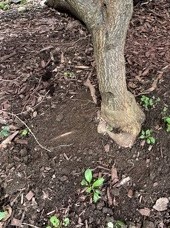
We had this Japanese Maple planted by an arborist about four years ago. It’s grown quite large and it is higher than the first floor of our house now. It is a Bloodgood variety. The conditions are favourable in terms of light and soil.
In the last couple of months, it has shown leaf browning and drop on about half of the tree. I’ve been told that it appears to be girdling but I’m not sure whether to proceed to have an expensive treatment done. Can you take a look at this? My feeling is that it may be too late to recover and I should just plant something else. Can you tell if this is girdling from the base of the trunk? What’s the chance of recovery do you think? I realize that you are dealing with limited information but any thoughts on the effectiveness of treatment for girdling would be appreciated The plan is to use an air compressor to remove the surrounding soil, cut roots and apply rubber mulch. If we go for fertilizer treatments,etc in addition to this, it will cost almost 1000.00 so we may just have the one treatment which is expensive enough!
Thanks kindly.
Sorry to hear about your Japanese Maple tree. Unfortunately, I am unable to tell from the photo whether it is girdling from the base of the trunk. Removing some of the top few inches of the soil from around your tree should verify whether your tree is suffering from girdling roots. Have you consulted a certified arborist? I have never heard of a certified arborist applying rubber mulch. Rubber mulch will not decompose and will not provide organic material to the soil. Rubber mulch may also contain chemical residues which are harmful to plants.
If you have contacted an arborist you may wish to get a second opinion. Landscape Ontario provides lists of various experts, including arborists, in your area.
The following information is from one of our earlier posts on girdling roots. The post talks about girdling roots on an Ivory Silk Lilac, but the information is also relevant to your tree.
“It sounds like you want to do everything you can for your Syringa reticulata ‘Ivory Silk’ ( Japanese tree lilac)! It is not possible to accurately predict if or when the tree will fully recover, as it can take several years for roots to regenerate, and other factors may come into play. Be patient, if the tree’s health does not seem to be declining, it may well recover.
When tree roots are severed, the balance between the crown (top) of the tree and its root system is altered, which is stressful for the tree. For example, the roots you removed may have supplied some of the water and nutrients to the tree canopy, and the tree will need time to compensate for this loss. As well, removing the girdling root created a wound, which could leave the tree more vulnerable to disease and pests.
I mentioned that other issues may affect a tree’s recovery time. For example, the season the girdling roots are removed may have some impact; Johnson (see link below) notes that in a study involving red maple trees, root removal in the summer resulted in better growth over a 2-year period than when the roots were removed during the fall or summer/fall combination. Although this study related to a different tree than yours, it illustrates that there may be other factors that impact tree recovery, which we have not considered.
In any event, best practices to enhance recovery of the tree after removal of girdling roots include:
- Water the tree deeply and well, over the entire root system, especially during dry periods over the summer.
- A light surface mulch on the exposed roots helps retain soil moisture. Do not pile mulch on the trunk flare – it should not touch the trunk.
- Prune any dead branches every couple of years. Expect branch dieback, this is normal during the recovery process.
- Consider whether the soil is deficient in nutrients, which could contribute to the stunted/yellowing leaves. If this is the case, slow-release nitrogen fertilizers may benefit the tree. Caution – don’t overdo it — excessive fertilizer could result in too much above-ground growth, stressing the already weakened stem and root system.
Here are links to a couple of good resources:
- Missouri Botanical Garden. Girdling roots.
- University of Minnesota. Johnson GR. A practitioner’s guide to stem girdling roots of trees. (2000)
Good Luck with your tree.

